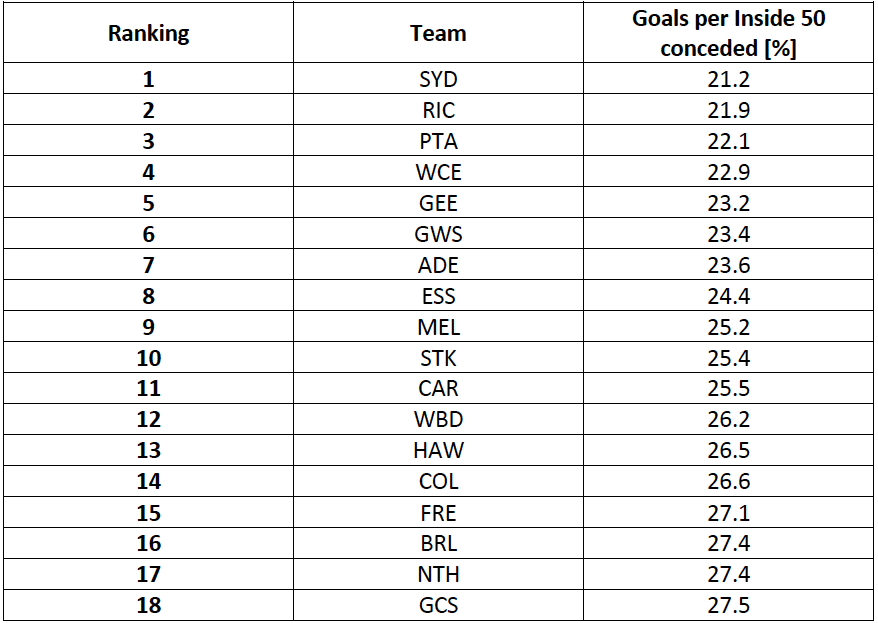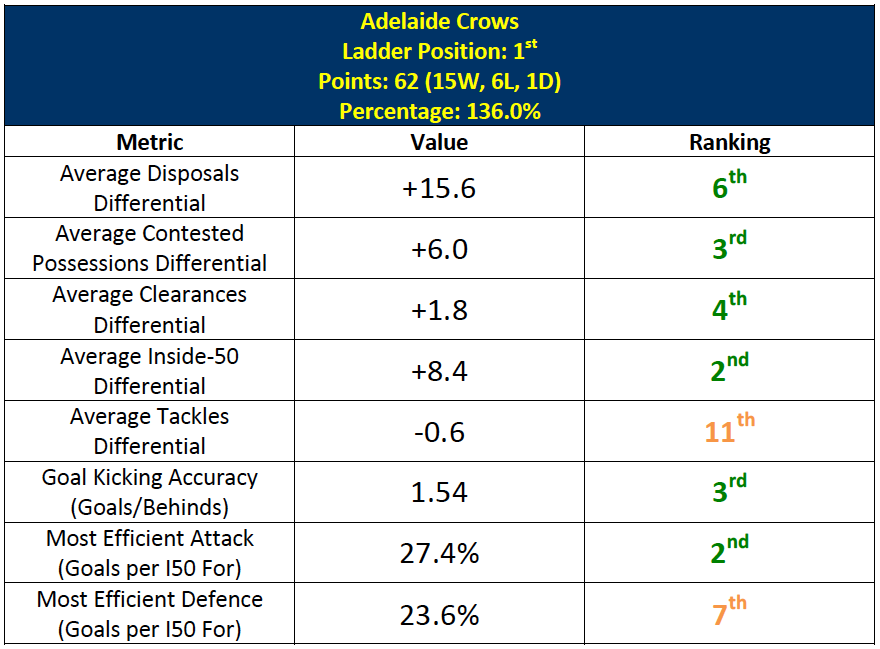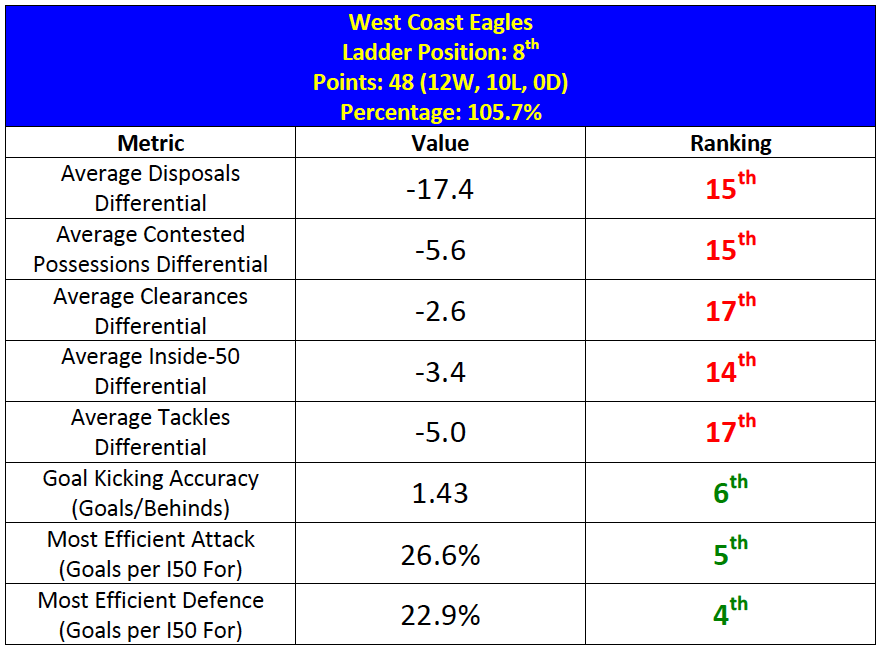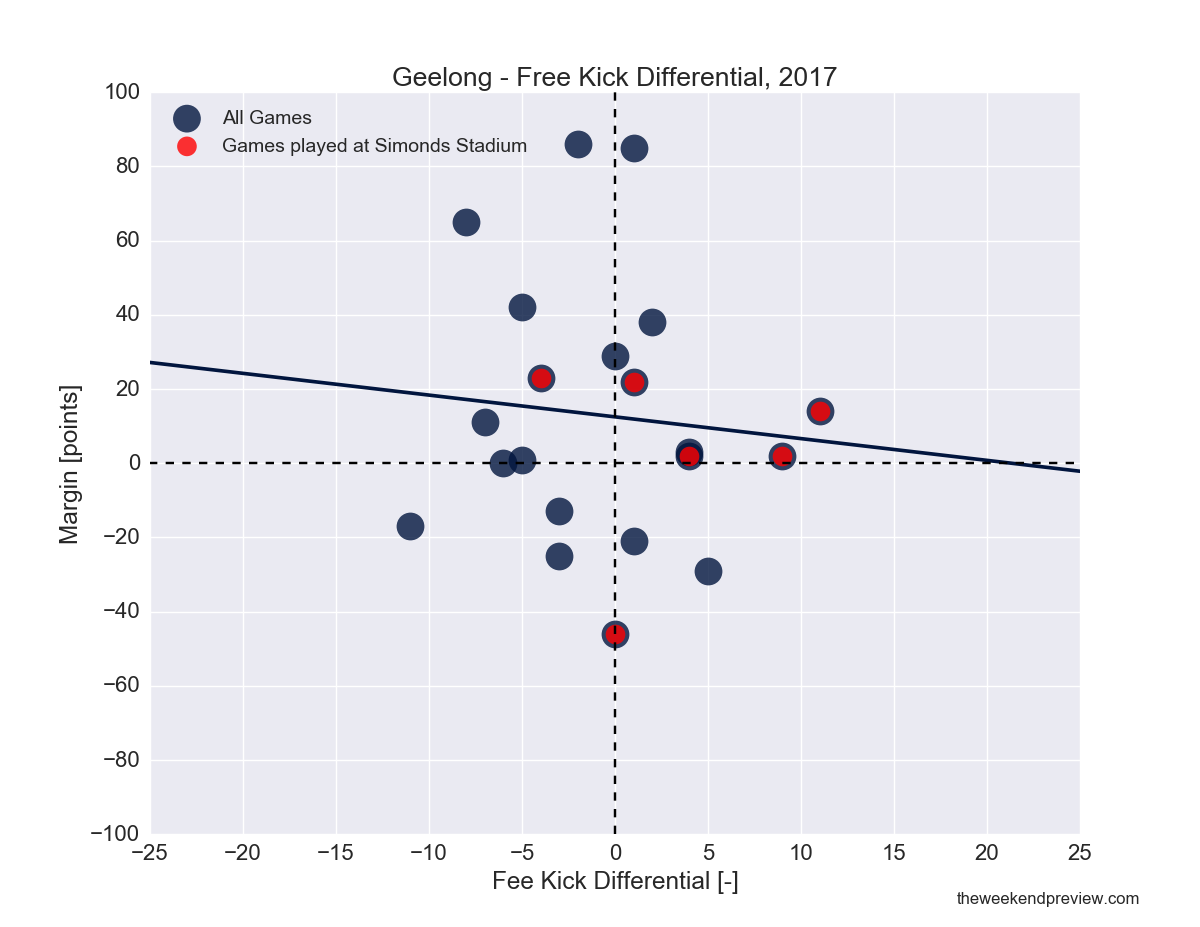AFL Finals Preview Special
We’re just a team within a team – defence wins premierships.
Josh Gibson [1]
It might be a little simplistic to say that defence alone wins premierships, but as 3x premiership winning defender Josh Gibson suggests, the defensive team within a team is crucial to premiership success. At the very least, you need a functioning defensive unit to guarantee a spot in September. In fact, the 8 teams playing finals in 2017 have the 8 best defences in the AFL. And the 9th best was Melbourne.
To measure each team’s defence in isolation, the goals conceded per inside forward 50 metric is used. As a metric, it ignores the number of forward 50 entries from the evaluation of a team's defence and focuses purely on the ability of the defensive unit in stopping the opposition from turning opportunities into goals. Table-1 and Figure-1 present the goals conceded per inside forward 50 rankings after Round 23. It may have correctly predicted the Top-8, but the order is a bit off. Then again, who’s to say we won’t see a Sydney versus Richmond Grand Final in four weeks time.
Table-1: 2017 Defence Efficiency Rankings – GPI50 conceded
Figure-1: 2017 Defence Efficiency Rankings – GPI50 conceded
----------
With what appears to be a very open Finals series, it is hoped that the next four weeks will be as exciting and unpredictable as the rest of the season. But to help guide you through it, The Weekend Preview has assessed the strengths and weaknesses of all the 8 finalists.
Note on the colour systems: In the presented tables, if a team is ranked in the top 6 of a given statistic, they are highlighted green and are considered above average for that metric. If a team is ranked between 7th and 12th of a given statistic they are highlighted orange and are considered average for that metric. If a team is ranked in the bottom 6 of a given statistic, they are highlighted red and are considered below average for that metric.
Adelaide Crows:
Adelaide is the most balanced side in the competition and they were the deserved minor premiers. Their midfield is their supposed weakness, however, they ranked 3rd for contested possession differential, 4th for clearances differential and 2nd for inside forward 50 differential. They are not a noted tackling team, ranking 11th, yet they possess the number 1 tackler in the AFL (Rory Sloane). What makes Adelaide particularly potent is that their forward line converts their plentiful opportunities, as they rank 3rd for goal kicking accuracy and 2nd for goals per inside forward 50. Adelaide’s only minor weakness is their defence, ranking 7th for goals conceded per inside forward 50. Adelaide will be setting out to defy the popular belief that defence wins premierships.
Adelaide will be hoping to stop their faltering late season form and bounce back from their consecutive losses to the Swans and the Eagles. They should be strengthened by the return from injury of Captain Taylor Walker and full back Daniel Talia, whilst they remain optimistic that Rory Sloane will recover in time from his appendicitis. They will also likely recall Hugh Greenwood to further strengthen themselves around the contest against GWS. Alex Keath, Paul Seedsman and Wayne Milera would be the most likely three to make way.
Table-2: Adelaide Summary Statistics
Geelong Cats:
Led by Patrick Dangerfield and Joel Selwood, Geelong was the number 1 contested ball team in the AFL in the 2017 home and away season. Yet strangely they have not always been able to convert this into domination of the clearances (ranked 10th) or inside forward 50s (ranked 7th). And as per Adelaide they are not a high tackling side, although when fit, they possess a player (Scott Selwood) that has been a tackling machine, recording an AFL best 11.6 tackles per game. Taking their much vaunted midfield aside, both Geelong’s forward line (4th for goals per inside 50) and defence (5th for goals conceded per inside 50) are doing their job efficiently. Yet the knock on the Cats is that most of their best wins this season have come at home at Simonds Stadium (think of their wins against fellow top 5 sides Adelaide, Richmond, GWS and Port Adelaide). Their form at the MCG has been less convincing, losing to both Essendon and Collingwood earlier in the season, and more recently only just getting over the line against Hawthorn and Collingwood in their Round 22 rematch.
The Round 23 convincing win over GWS will be a big morale booster heading into the Finals, yet their home final against Richmond is not the home ground advantage they would be hoping for. Geelong should be boosted by the return of Joel Selwood, and I suspect they would be keen to bring in Nakia Cockatoo if fit. Brandon Parfitt and perhaps Wylie Buzza may be the unlucky ones if they do return. Rhys Stanley is another tall option if the need arises for more ruck/forward support later in the Finals.
Table-3: Geelong Summary Statistics
Richmond Tigers:
Dustin Martin may have been the hottest property on the market and his captain Trent Cotchin may have been unlucky to miss the All-Australian squad of 40, but it was not the midfield that secured the Tigers a Top 4 spot. It was the Tigers defence, led by All Australian Captain Alex Rance that has been the backbone of their success this season. Richmond was second only to Sydney in the number of goals per inside 50 that they concede. The Tigers are not a strong contested ball team, nor do they dominate the clearances. But what they are good at is pressuring the opposition, ranking 4th for tackles differential. But whilst their fleet of small forwards are good at applying pressure, they are let down by their poor goal kicking, ranking 14th for goal kicking accuracy. Kick straight and they could have even been minor premiers!
The Tigers are flying into finals after two dominant wins to close out their home and away season. Hence, you would think that the Tigers will be resistant to make too many changes to their side, but they will likely find a place for Josh Caddy. His replacement for the last two rounds of the season was Jacob Townsend, who has been a revelation kicking 11 goals in two games. So perhaps it may be the unlucky Jack Graham or Oleg Markov who is left out for the returning Caddy.
Table-4: Richmond Summary Statistics
GWS Giants:
GWS were by far and away the best clearance side in the AFL, winning the clearances count by an average of 7.7 clearances per game. By comparison, Collingwood were 2nd with an average of +2.5 clearances per game. Yet the Giants have not been the all-conquering team most people expected them to be. They haven’t been able to convert their dominance at the clearances into territorial dominance (ranking 9th for forward 50 differential) and once in their forward 50 they are only 10th for goal kicking accuracy and 7th for goals per inside forward 50. This means that even when the Giants are dominating the midfield battle, they are not putting away their opposition. The Giants still have some improvement before they become the team we all fear they will one day be.
Despite their much publicised injury crisis this season, the Giants were at virtually full strength by Round 23. Which makes their poor performance against Geelong all the more disappointing. Of the unavailable players without season ending injuries, only Ryan Griffin would be in their best 22. And given he hasn’t played since Round 3, I doubt they will rush him back in. Which leaves probably only Steve Johnson’s position in question. But surely the upside of Stevie J is higher than a Matt de Boer. So the Giants may well be unchanged going into their Qualifying Final against the Crows.
Table-5: GWS Summary Statistics
Port Adelaide Power:
Port Adelaide has been dismissed by many a pundit as a premiership chance due to their perceived inability to beat top opposition. Of the Top 8, Port Adelaide only managed to beat Sydney in Round 1 and West Coast in Round 16. It is true that the Power has beaten up on poor opposition, and it is a big reason why they rank 1st for inside forward 50 differential. However, we are probably paying the Power a bit of disservice. The Power ranked 3rd in the AFL for goals conceded per inside forward 50 entry, meaning their defence is underrated. What is likely to be their biggest downfall is their poor goal kicking, ranking 15th for goal kicking accuracy and as a result only ranked 12th for goals scored per inside forward 50 entry.
With solid wins against the Magpies and the Bulldogs, followed by a thumping of the Suns in Round 23, the Power at the very least are entering September in good form. They will also likely welcome the return of some experienced players in Matthew Broadbent, Jackson Trengrove and potentially Jarman Impey, at the probable expense of Todd Marshall, Aidyn Johnson and Riley Bonner. So there may still be some improvement in the Power yet.
Table-6: Port Adelaide Summary Statistics
Sydney Swans:
Despite only finishing 6th on the ladder at the end of the home and away season, all the finalists will be hoping to avoid Sydney in September. The undoubted form team of the competition, the Swans won 14 of their last 16 games including away wins against all of the Top 4. Their 0-6 start to the season is now a distant memory. But looking at the stats, aside from their defence, their overall performance has been less than impressive. The Swans have the best defence in the league, conceding goals per inside forward 50 at a league leading rate of 21.2%. Yet, around the ground they are nowhere near their former self. Their midfield led by Josh Kennedy, Luke Parker and Dan Hannebery, ranked only 7th for contested possessions and 7th for clearances. And their forward line although ranking 6th for goals per inside forward 50, were still inaccurate, ranking 12th. Unless you wholly prescribe to the notion that defence wins premierships, the Swans will need further support from their midfielders and forwards if they hope to raise the premiership cup.
Luckily for the Swans, it appears their forward line is coming into form at just the right time, with Coleman Medallist Buddy Franklin’s 10-goal haul in Round 23 just the performance they needed ahead of a Finals campaign. And they will likely be strengthened by the return of Dan Hannebery and Tom Papley for the Elimination Final against Essendon. Harry Cunningham and Dean Towers are the most likely two to make way. The Swans also have the selection dilemma of whether to bring back Sam Naismith ahead of the in-form Callum Sinclair.
Table-7: Sydney Summary Statistics
Essendon Bombers:
If Sydney has the strongest defence of all the finalists, the Bombers have the weakest. But the Bombers game plan is to outrun and outscore their opposition. The Bombers don’t win a lot of contested possessions, nor are they very good at getting the clearances. However, they are very good at pressuring the opposition (ranked 3rd in tackles differential) and making their forward entries count (ranked 3rd for goals per inside 50). All this makes Essendon such an interesting team to watch; their ability to both score quick goals and concede them means there is always action to the very end.
Essendon's end to the season was not too convincing, with their generous draw a big help in them making the Finals. And they have probably not been at their best since their 10-goal win against St Kilda in Round 17. But the expected return of Michael Hurley, Cale Hooker and Orazio Fantasia will be a big boost for them entering finals, at the probable expense of Jayden Laverde, Heath Hocking and Joshua Begley. And as the Swans found out earlier this season, they are potentially a tricky opponent.
Table-8: Essendon Summary Statistics
West Coast Eagles:
West Coast was ranked 15th for disposals differential, 15th for contested possessions differential, 17th for clearances differential, 14th for inside forward 50 differential and 17th for tackles differential. Doesn’t sound like the form of a credible finalist let alone premiership contender does it? So how did they find their way into the Top-8? Quite simply they have an above average forward line and defence. Led by Josh Kennedy at full forward, West Coast was 6th in goal kicking accuracy and 5th for goals per inside forward 50. Whilst their defensive unit was ranked 4th for goals conceded per inside 50. But can they go far in September with such an underperforming midfield? Probably not, so no wonder they appear so desperate for Nic Natainui to come back into the fold.
Finishing off the season on a high with their entertaining win over the Crows, the Eagles enter the Finals with a nothing to lose mindset. An underdone Nic Nat will surely not be the difference and I would hope the Eagles err on the side of caution with their valuable asset. The only possible change I can envision the Eagles making is to bolster their experience, perhaps bringing in Chris Masten for Luke Partington. But more than likely the Eagles will stay unchanged and try to carry their Round 23 momentum as far as they can.
Table-9: West Coast Summary Statistics
----------
[1] Duxson, N. “Snapshot: Quotes that matter”. October 6, 2015.
http://www.hawthornfc.com.au/news/2015-10-06/snapshot-quotes-that-matter












